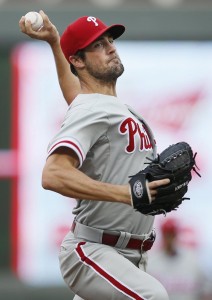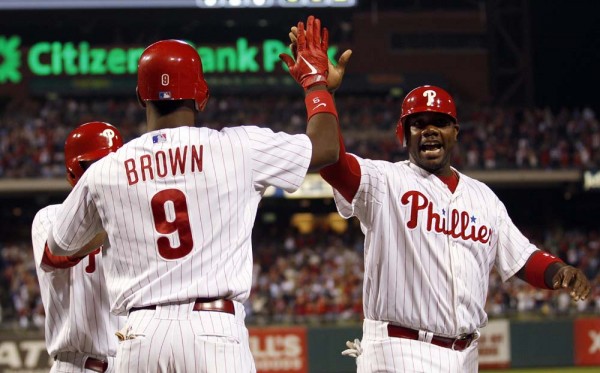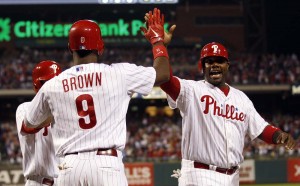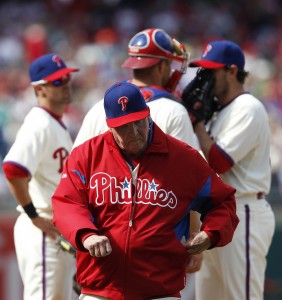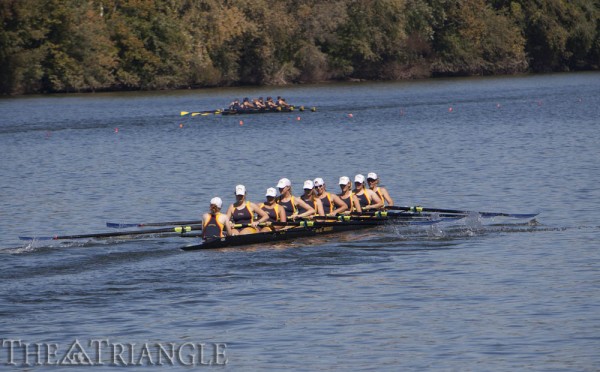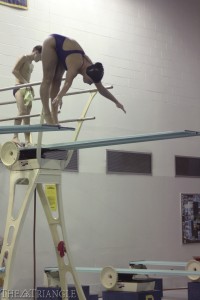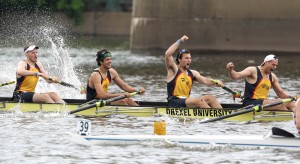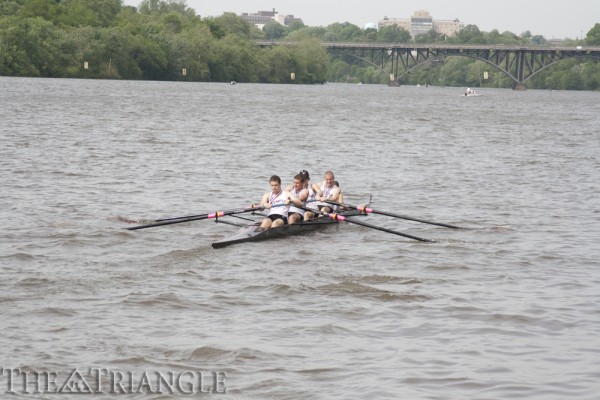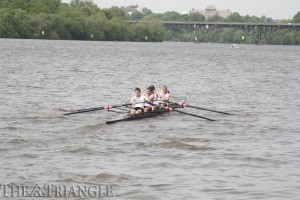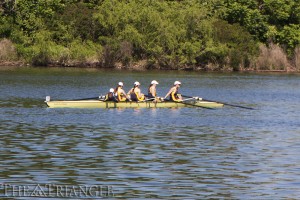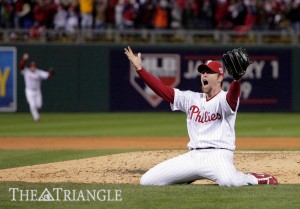
 Five years can be longer than you think, and the Philadelphia Phillies had this brought to their attention last week. The organization welcomed back Brad Lidge, the delivery man of the final out that clinched the franchise’s most recent World Series in 2008, as he signed a one-day contract Aug. 1 to retire as a Phillie.
Five years can be longer than you think, and the Philadelphia Phillies had this brought to their attention last week. The organization welcomed back Brad Lidge, the delivery man of the final out that clinched the franchise’s most recent World Series in 2008, as he signed a one-day contract Aug. 1 to retire as a Phillie.
With Lidge in town to kick off the Phillies’ annual Alumni Weekend, the team briefly looked back on his perfect season, in which he saved 48 games in 48 opportunities. Everyone in the park was reminded of the season and the championship team when the final moments of Game 5 of the World Series were played on the scoreboard.
Lidge waited in the bullpen, watching Cole Hamels warm up for his start against the San Francisco Giants. The final call by Harry Kalas was played from Lidge’s Game 5 strikeout of Eric Hinske, a game started by Hamels against the Tampa Bay Rays.
Immediately after the replay ended, Dan Baker announced for the final time, “Now pitching for the Phillies, batting in the ninth position, No. 54, Brad Lidge!”
Lidge emerged for one last trot out of the bullpen. “On your feet, who’s with me? On your feet, let’s go!” blared through the speakers once again from his signature introductory song, “Soldiers” by Drowning Pool. He picked up the ball from the mound and threw it to Carlos Ruiz, who just like before, was awaiting him from behind the plate. The two embraced one more time, just as they so often did after each of Lidge’s 100 career saves with the team.
For a brief moment it was 2008 again, and the perfect Lidge was the icon of everything going right and well for the Phillies. So when he walked off the field, now as a retired ballplayer, reality resumed and returned the current scene of the 2013 Phillies season.
The game started, and Hamels was no longer pursuing postseason history with a record number of wins. Instead, his 4-13 record and four-plus ERA flashed on the board, as he is in the midst of trying to avoid a 20-loss season.
The team’s most important offensive player, Ryan Howard, was nowhere to be found on the lineup card as age and wear and tear caught up to him, forcing yet another stint on the disabled list. His complimentary power threats of Pat Burrell and Jayson Werth were replaced with Delmon Young and Laynce Nix in the corner outfield positions. Solid all-around contributors Pedro Feliz and Shane Victorino were replaced with Cody Asche and John Mayberry Jr.
Suddenly, it seemed like a much longer distance between now and Lidge’s pitches, the nonceremonial ones.
Nothing confirmed that more than the ninth inning. With the Phillies taking a one-run lead into the final frame, Jonathan Papelbon blew his sixth save of the season. By comparison, in Lidge’s 41 regular-season save opportunities in 2008, he gave up runs in only five of those games, of course never blowing one.
Then, the Phillies fell behind and failed to come back. Nix — a far cry from the likes of Geoff Jenkins, Matt Stairs and Greg Dobbs from the 2008 bench — failed to get the clutch hit with the bases loaded and no outs. Even Ruiz failed to come through, as his many clutch hits in the 2008 postseason were now a distant memory.
Five years ago, the Phillies do not lose that game. Even in years since then, they at least tie it in the ninth after loading the bases with no outs in a one-run game at home. What a fall from the top.
The contrasting scenes and emotions from the pregame ceremony and the game itself highlighted just how important a bullpen and a complete team with solid depth in general are for success.
You will not find a deeper unit than the 2008 Phillies bullpen. Lidge credited the extraordinary depth, assembled by former general manager Pat Gillick, in his retirement press conference.
“A huge part of the success was the guys in front of me,” Lidge said. “[Ryan] Madson, J.C. [Romero], [Chad] Durbin, [Scott] Eyre, all those guys were amazing that year.”
That group, filled out by Rudy Seanez and Clay Condrey, had the lowest bullpen ERA in the National League that season at 3.22. It has been well documented that the Phillies since then have taken a step back each season. It should be viewed as no coincidence that their bullpen ERA has also slightly risen each year, with the exception of 2011. But that year, they used the bullpen the fewest games in the league, and their relievers pitched 27 fewer innings than the next closest team.
Now, back in the reality of 2013, their bullpen sports an ERA of 4.29. So the Phillies essentially have to score an extra run per game today compared to 2008 just to make up for the bullpen’s decline. Their top three relievers of Papelbon; Mike Adams, who has been as delicate as a China doll; and the now suspended Antonio Bastardo are a far cry from Lidge and the “Bridge to Lidge” created by Chad Durbin and Ryan Madson.
And the unit is not nearly as close or cohesive as the 2008 squad. That season, the bullpen got its own TV reality show, “The Pen,” because of how great of a collective unit it was. Lidge confirmed that this cohesion contributed to their success.
“We had such a tight group that year, but I think that went a long way with the success,” he said.
It is no secret that Papelbon is in his own world in the clubhouse. There are no imminent plans to profile the 2013 bullpen in a reality show, unless the title would be “Death of a Ballclub.”
It has become clear, not just with the Phillies but also with recent champions in San Francisco and Tony La Russa’s Cardinals, that a good bullpen gives a club a chance to lock down wins and overcome deficits. The Phillies were one of the grittiest come-from-behind teams in baseball until the demise of the bullpen. Players like Chase Utley and Jimmy Rollins often talked about how the team would be sure to come back, just as long as the bullpen could give them a chance.
Lidge and his mates knew this.
“The guys in the clubhouse would always say, ‘Just give us a chance,’” he said. “‘As long as you give us a chance, keep the score there and we’re going to come back.’ And they would do it so often.”
Now a three-run deficit seems insurmountable, just because the mountain continues to grow when the likes of Raul Valdes and Justin De Fratus come in and fail to stop the bleeding.
Long gone are those characters from “The Pen.” Five years later, there is not one member from the bullpen on the Phillies’ 40-man roster, and only five total players from the 2008 postseason roster are still in red pinstripes.
And now, the 2013 team has no chance; they are constantly being robbed by their bullpen. Oh, how long ago five years seems.
The post What’s going on with the Phillies bullpen? appeared first on The Triangle.

